.gif)
Jumping (horse)
Encyclopedia
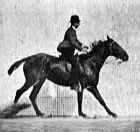
Equestrianism
Equestrianism more often known as riding, horseback riding or horse riding refers to the skill of riding, driving, or vaulting with horses...
, such as show jumping
Show jumping
Show jumping, also known as "stadium jumping," "open jumping," or "jumpers," is a member of a family of English riding equestrian events that also includes dressage, eventing, hunters, and equitation. Jumping classes commonly are seen at horse shows throughout the world, including the Olympics...
, fox hunting
Fox hunting
Fox hunting is an activity involving the tracking, chase, and sometimes killing of a fox, traditionally a red fox, by trained foxhounds or other scent hounds, and a group of followers led by a master of foxhounds, who follow the hounds on foot or on horseback.Fox hunting originated in its current...
, steeplechasing
Steeplechase
Steeplechase may refer to:* Steeplechase, an event in horse racing* SteepleChase, a Danish jazz label* Steeplechase , a 1975 arcade game released by Atari...
, and eventing
Eventing
Eventing is an equestrian event comprising dressage, cross-country, and show jumping. This event has its roots in a comprehensive cavalry test requiring mastery of several types of riding...
. The biomechanics
Biomechanics
Biomechanics is the application of mechanical principles to biological systems, such as humans, animals, plants, organs, and cells. Perhaps one of the best definitions was provided by Herbert Hatze in 1974: "Biomechanics is the study of the structure and function of biological systems by means of...
of jumping, the influence of the rider, and the heritability
Heritability
The Heritability of a population is the proportion of observable differences between individuals that is due to genetic differences. Factors including genetics, environment and random chance can all contribute to the variation between individuals in their observable characteristics...
of jumping prowess have all been the focus of research.
Jumping process
The airborne phase of the jumping process occurs between stance phases of the fore and hind limbs, and is therefore biomechanicallyBiomechanics
Biomechanics is the application of mechanical principles to biological systems, such as humans, animals, plants, organs, and cells. Perhaps one of the best definitions was provided by Herbert Hatze in 1974: "Biomechanics is the study of the structure and function of biological systems by means of...
equivalent to a highly suspended or elevated canter
Canter
The canter is a controlled, three-beat gait performed by a horse. It is a natural gait possessed by all horses, faster than most horses' trot but slower than the gallop, and is used by all riders. The speed of the canter varies between 16-27 km/h , depending on the length of the stride of the horse...
stride. For this reason, horses typically approach obstacles
Horse jumping obstacles
Various obstacles are found in competitive sports involving Horse jumping. These include show jumping, hunter, and the cross-country phase of the equestrian discipline of eventing. The size and type of obstacles vary depending on the course and the level of the horse and rider, but all horses must...
at the canter. The jumping process can be broken down into five phases:

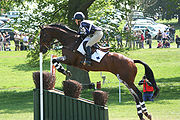
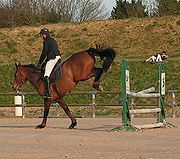
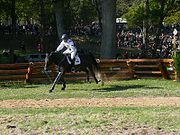
Approach
The "approach" is the final canter strideStride
Stride can stand for:* A period of locomotion defined by the complete cycle of a reference limb. See gait* In music:** STRIDE - An indie rock n roll band from North East Scotland** Stride , a type of piano playing...
before the jump, during which the horse places all four legs for the optimal take-off. The horse reaches forward and down with his neck to lower the forehand and his center of mass
Center of mass
In physics, the center of mass or barycenter of a system is the average location of all of its mass. In the case of a rigid body, the position of the center of mass is fixed in relation to the body...
. The forelegs are propped or strutted out in front of the body. This relatively sudden braking action allows momentum to carry the hindlegs further under the body of the horse than would be otherwise possible. While the action is more fluid, it is mechanically similar to the act of crouching down before jumping.
Take-off
The "take-off" begins when the forelegs leave the ground and is completed when the hindlegs leave the ground. Once the horse leaves the ground, he is unable to influence the trajectoryTrajectory
A trajectory is the path that a moving object follows through space as a function of time. The object might be a projectile or a satellite, for example. It thus includes the meaning of orbit—the path of a planet, an asteroid or a comet as it travels around a central mass...
that his center of mass follows through the air, which makes take-off the most critical phase of the jumping process. Most of the energy required to clear an obstacle is produced by the hind legs. The longer the hindlegs are in contact with the ground, the greater their capacity for producing power; the further forward the hindlegs are placed under the body, closer to the obsctacle, the longer this stance phase. Power is produced by the compression of the hindleg, which flexes at the hip, stifle
Stifle
Stifle can mean:* To suffocate* To prevent from speaking or to prevent a view being heard. See free speech, gag and gagging.A stifle is also the name for an animal's knee joint. See stifle joint....
, hock
Hock
The word hock may mean:* Hock , a type of wine* Hock , part of an animal's leg* Ham hock, a meat joint from the lower leg of a pig* To leave an item with a pawnbroker* Hans Henrich Hock, German historical linguist...
, and fetlock
Fetlock
Fetlock is the common name for the metacarpophalangeal and metatarsophalangeal joints of horses, large animals, and sometimes dogs. It is formed by the junction of the third metacarpal or metatarsal bones proximad and the proximal phalanx distad...
, and then releases energy like a spring.
Flight, suspension, or airborne phase
During "flight", the horse's center of mass follows a parabolicParabola
In mathematics, the parabola is a conic section, the intersection of a right circular conical surface and a plane parallel to a generating straight line of that surface...
trajectory over which it has no control. The horse can change the position of its legs and body in relation to the center of mass, however, which is critical to clearing an obstacle safely. The horse's body rotates through the air, a quality called "bascule", to ensure that while the forehand clears the fence, the shoulders are the highest point of the body, and while the hind end clears the fence, the hips are the highest point of the body. The forelegs are drawn up towards the body and the hindlegs are "retroflexed" out away from the body to clear the obstacle. During flight, the rider has little impact on the actual trajectory of the horse's body. Foals frequently change leads when jumping.
Landing
The horse lands first with the trailing (non-leading) foreleg, and then with the lead foreleg. The hind limbs follow suit. The landing places a great deal of strain on the forelegs, which can lead to injuries or lameness over time.Recovery, getaway
During the first stride after the jump, the horse re-balances himself. Horses sometimes react to discomfort or high emotion during the recovery, and may buck, bolt, or toss their heads.Injuries and lameness associated with jumping
Jumping is a very strenuous activity that places high physical demands on the horse. The primary stresses affect the suspensory apparatuses of the hind legs during take-off and the forelegs during landing, though the galloping and turning associated with jumping also place torque on the joints. Most injuries, chronic or acute, begin with strainDeformation (mechanics)
Deformation in continuum mechanics is the transformation of a body from a reference configuration to a current configuration. A configuration is a set containing the positions of all particles of the body...
; as structures in the horse's body absorb the shock of take-off and landing, they acquire small amounts of damage. Over time, this damage leads to inflammation
Inflammation
Inflammation is part of the complex biological response of vascular tissues to harmful stimuli, such as pathogens, damaged cells, or irritants. Inflammation is a protective attempt by the organism to remove the injurious stimuli and to initiate the healing process...
of the tendons (tendinitis) and ligaments (desmitis). The most common injuries in the forelimb occur to the interosseous ligaments
Splints
Splints is an ailment of the horse or pony, characterized by a hard, bony swelling, usually on the inside of a front leg, lying between the splint and cannon bone or on the splint bone itself. It may be "hot," meaning that it occurred recently and is still painful; or "cold," meaning that the...
and the superficial digital flexor tendons, and less commonly the accessory ligament of the deep digital flexor tendon. Strain
Deformation (mechanics)
Deformation in continuum mechanics is the transformation of a body from a reference configuration to a current configuration. A configuration is a set containing the positions of all particles of the body...
on the superficial digital flexors is greater when jumping higher fences, so horses may no longer be suitable for competitive jumping after damaging that apparatus.
The effects of jumping on the hind legs can include injuries to the proximal, medial, or lateral branches of the suspensory ligaments. Jumping horses can also be at a higher risk of developing osteochondritis dissecans
Osteochondritis dissecans
Osteochondritis dissecans , often abbreviated to OCD or OD, is a joint disorder in which cracks form in the articular cartilage and the underlying subchondral bone. OCD is caused by blood deprivation in the subchondral bone. This loss of blood flow causes the subchondral bone to die in a process...
(OCD) or other arthritic
Arthritis
Arthritis is a form of joint disorder that involves inflammation of one or more joints....
conditions, even at a young age. Genetic and environmental components play roles in the development of OCD in horses: some families have weaker joints, but excessive growth over a short period of time, age-inappropriate exercise regimens and nutrition can also contribute. Jumping performance is especially impacted by the presence of arthropathic hocks. One study found that at breeding stock evaluations, horses with radiographically-diagnosed athropathies of the hock joints scored significantly lower than their healthy peers for the quality of the canter, jumping technique and ability, and their character. The pain associated with arthropathic conditions likely makes the horses unwilling to push powerfully off their hindlegs, a quality necessary for jumping and cantering, and which could make the horse appear lazy or unwilling to work.
Indications of lameness in jumping horses typically come in the form of a change in habits: sudden or developing reluctance to turn, to land on a certain lead, to "add" a stride and jump "deep", difficulties altering the stride length or make the distances in a combination, and developing habits like rushing, stopping and refusing, or frequent lead changes. Unfortunately, many of these undesirable habits can also be the result of poor training, which challenges riders and owners to identify the causes of bad behavior.
World records
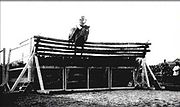
World record
A world record is usually the best global performance ever recorded and verified in a specific skill or sport. The book Guinness World Records collates and publishes notable records of all types, from first and best to worst human achievements, to extremes in the natural world and beyond...
for the highest obstacle cleared by a horse and rider was set on February 5, 1949 by Huaso
Huaso (horse)
Huaso was the horse that, ridden by Chilean Captain Alberto Larraguibel, set the high-jump world record on February 5, 1949, by jumping in Viña del Mar, Chile, one of the longest-running unbroken sport records in history * Color: Chestnut* Markings: Star, forehead* Height: * Sex: Stallion* Breed:...
and his rider, Captain Alberto Larraguibel
Alberto Larraguibel
Colonel Alberto Larraguibel Morales was a Chilean Army officer of Basque descent born in Angol, Chile. He remains the record holder for Puissance on Horseback, one of the longest-running unbroken sport records in history -- years as of .Then-Captain Larraguibel broke the record for the...
. The Thoroughbred
Thoroughbred
The Thoroughbred is a horse breed best known for its use in horse racing. Although the word thoroughbred is sometimes used to refer to any breed of purebred horse, it technically refers only to the Thoroughbred breed...
stallion
Stallion
A Stallion is a male horse.Stallion may also refer to:* Stallion , an American pop rock group* Stallion , a figure in the Gobot toyline* Stallion , a character in the console role-playing game series...
and his Chilean rider cleared a fence measuring 2.47 meters (8 ft. 1¼ in.) high. This record has stood for 60 years. This record is held separately from the record height jumped in Puissance
Puissance
Puissance is the high-jump competition in the equestrian sport of show jumping.The competition involves a maximum of five rounds - opening round followed by four jump-offs not against the clock. The first round consists of four to six large single obstacles including the puissance wall, the...
classes, regularly held high jump competitions at horse shows. The record for highest obstacle cleared by a horse and rider in a Puissance competition is held by Leonardo and his rider, Franke Sloothaak
Franke Sloothaak
Franke Sloothaak is a German show jumping champion, Olympic champion from 1988 and 1996.-Olympic Record:...
. In 1991, this pair jumped a puissance wall standing 7 feet 10 inches high.
Horses are also capable of jumping obstacles of great width. The world record long jump was set on April 26, 1975 by a horse named "Something" ridden by a Mr. Andre Ferreira. This pair jumped a distance of 8.40 meters (27 ft. 6 in.).
See also
- Horse jumping obstaclesHorse jumping obstaclesVarious obstacles are found in competitive sports involving Horse jumping. These include show jumping, hunter, and the cross-country phase of the equestrian discipline of eventing. The size and type of obstacles vary depending on the course and the level of the horse and rider, but all horses must...
- Show hunterShow hunterThe show hunter is a type of show horse that is judged on its movement, manners, and way of going, particularly while jumping fences. The horses are shown in hunt seat style tack, and are often of Warmblood or Thoroughbred type, though a hunter-style pony is also seen in youth classes...
- Show hunter (British)Show hunter (British)The show hunter is a type of show horse commonly seen at equestrian events across Britain. The British "show hunter" is shown primarily on the flat, while the "working hunter" must also jump a series of rustic fences .The governing body that oversees show hunter horses is Sport Horse Breeding ,...
- Hunter hackHunter hackHunter hack is a type of English pleasure class where exhibitors in Hunt seat tack and attire perform on the flat at a walk, trot, canter and hand gallop, and then jump two low fences...
- Show hunter (British)
- Field hunterField hunterA field hunter, or a fox hunter, is a type of horse used in the hunt field for fox hunting. It may be of any breed, but should possess stamina, a level head, and bravery. The horse should have a safe jump, so as not to get caught on any of the solid obstacles found in the hunt field...
- SteeplechaseSteeplechaseSteeplechase may refer to:* Steeplechase, an event in horse racing* SteepleChase, a Danish jazz label* Steeplechase , a 1975 arcade game released by Atari...
- Horse showHorse showA Horse show is a judged exhibition of horses and ponies. Many different horse breeds and equestrian disciplines hold competitions worldwide, from local to the international levels. Most horse shows run from one to three days, sometimes longer for major, all-breed events or national and...
- Equestrian at the Summer OlympicsEquestrian at the Summer OlympicsEquestrianism made its Summer Olympics debut at the 1900 Summer Olympics in Paris, France. It disappeared until 1912, but has appeared at every Summer Olympic Games since. The current Olympic equestrian disciplines are Dressage, Eventing, and Jumping...

